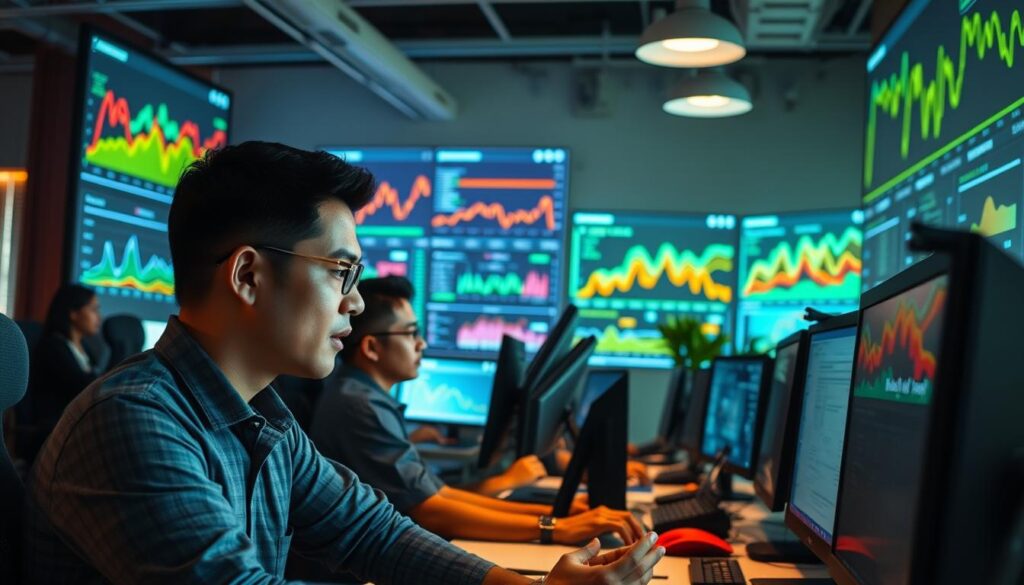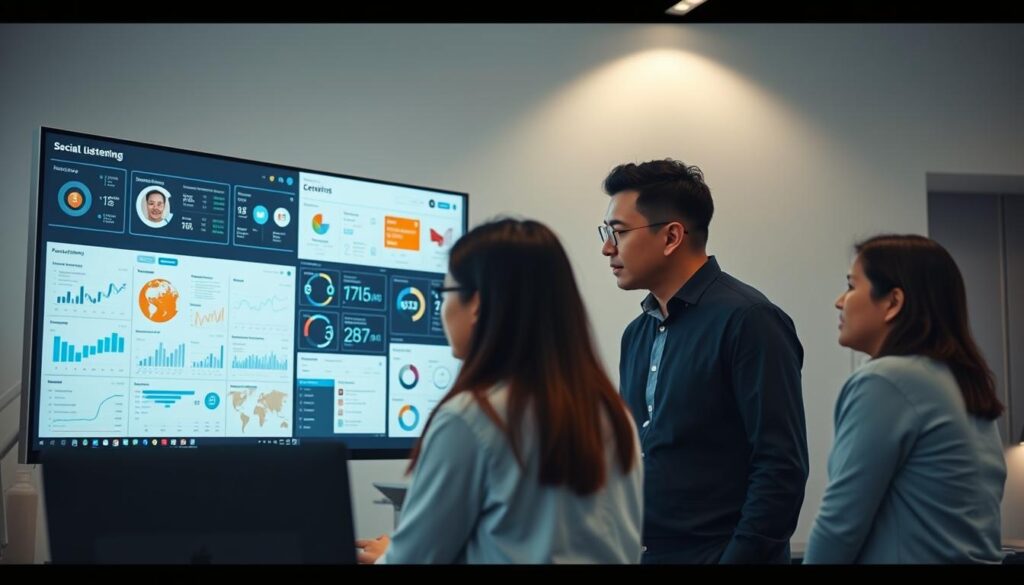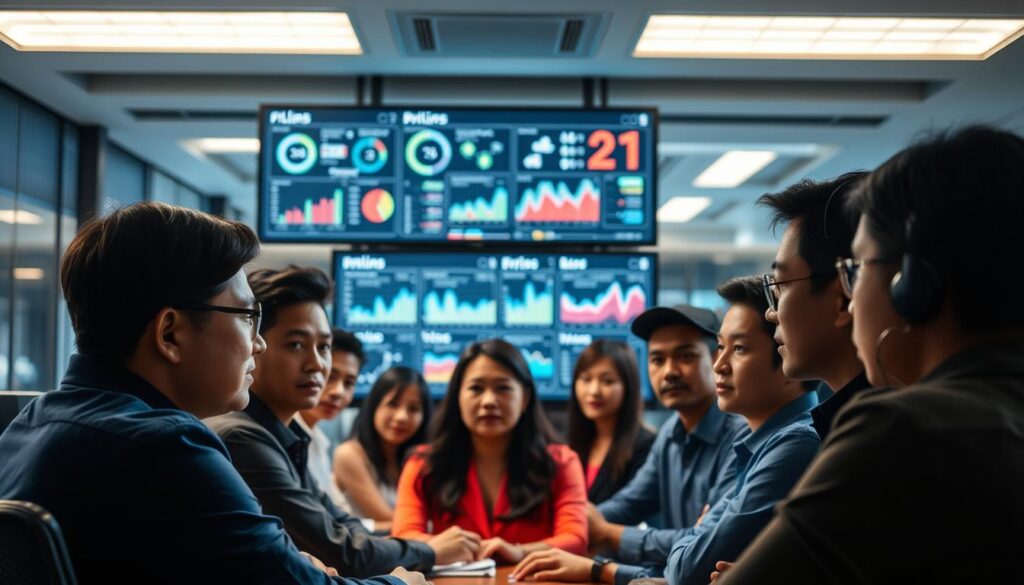In today’s fast-paced world, protecting your brand’s reputation is more critical than ever. Social listening for real-time crisis management is not just a strategy; it’s essential. With the rise of online conversations, businesses in markets like the Philippines must stay on top.
Social listening AI tools help organizations keep an eye on digital chatter. They spot potential issues early, allowing for quick action to protect your online image. This section dives into how these technologies can change how companies handle crises and keep their brand strong.
Key Takeaways
- Social listening allows timely detection of potential crises.
- AI enhances the effectiveness of social media crisis management.
- Proactive monitoring safeguards brand reputation.
- Understanding audience sentiment is crucial in crisis response.
- Engagement in real-time can mitigate damage during crises.
Understanding Social Listening in Crisis Management
Social listening is key in today’s fast world, crucial for crisis management. It helps track and analyze online talks about a brand. This way, businesses can understand what customers say and what people talk about their brand.
This skill is vital when facing crises. It lets companies spot problems early. This way, they can act fast and protect their reputation.
Definition and Importance
Social listening means watching online for mentions of a brand or its products. It helps understand what people think, which is key for managing a brand’s image. When crises hit, companies with good social listening can react quickly. This helps keep their reputation strong.
For example, Grab in Southeast Asia uses social listening well. They handle customer worries effectively.
How Social Listening Works
The steps of social listening include:
- Watching different platforms for brand mentions.
- Looking at feelings to see what customers think.
- Finding trends to spot new crises.
- Creating responses based on what’s learned to avoid bad outcomes.

Using social listening regularly helps brands manage crises better. It also makes their online image stronger. This way, they stay strong against challenges.
The Role of Social Listening AI in Crisis Management
Social listening AI is key in crisis management. It gives brands real-time insights when issues arise. These tools quickly scan through lots of data on social media, making old ways better.
By using social listening AI, businesses can spot trends and feelings fast. This lets them quickly respond to what customers say.
Using AI for Real-Time Insights
Companies get quick views on what people think during a crisis with social listening AI. This lets them respond fast, matching what customers feel. Brands can set alerts for certain words, so they can talk to their audience right away.
For example, watching things in real-time helps catch bad comments early. This lets brands fix problems fast and well.
Benefits of AI-Powered Tools
AI tools bring big benefits in crisis management:
- Speed: Quick monitoring means brands can act fast, reducing harm.
- Accuracy: Better algorithms give clear views on what customers do.
- Proactivity: Spotting issues early helps stop big problems.
- Engagement: Brands can adjust their talks based on what’s happening now, building better connections.
Companies like VinGroup in Vietnam show how social listening AI can change how they talk to customers and handle crises. Using these AI tools, brands can better handle tough times and keep their good name.

Social Media Crisis Management: Identifying Potential Crises
Spotting potential crises on social media takes sharp eyes and constant watching. Finding problems early is key to a brand’s quick response. By catching signs early, companies can craft a crisis plan that saves their reputation.
Early Warning Signs and Triggers
Watching social media gives insight into what customers think and feel. Look out for:
- Sudden increases in negative mentions about the brand
- Spike in customer complaints about products or services
- Trending keywords that show a growing problem
Keeping an eye on these signs helps businesses act fast. Social media changes fast, and spotting problems early helps avoid big crises.
Case Studies of Crisis Detection
Brands that catch problems early do better in crises. Many companies have shown how important this is. For instance, a retail site noticed growing dissatisfaction on social media.
This let them act quickly, reducing harm and keeping their good name. These stories highlight the value of a crisis plan based on early detection.

Real-Time Monitoring and Response during Crises
In today’s fast world, real-time monitoring is key for crisis management. Companies must stay alert and quick, watching social media and public opinions. This ensures they can respond fast. Delaying can make things worse, harming their reputation.

Being quick is crucial in a crisis. Fast actions show stakeholders that you care about being open and tackling problems. Companies with good monitoring can spot issues early, acting fast.
The Importance of Timeliness
Quick responses help limit damage in a crisis. Slow action can lose customer trust. But, acting fast can turn a bad situation into a chance to build trust and loyalty.
Tools for Effective Monitoring
Many tools help keep up with public views. Social media, monitoring software, and dashboards offer key insights. Tools like Hootsuite, Brandwatch, and Sprout Social are popular. They help businesses stay on top of things, keeping their crisis plans on track.
Building Brand Reputation Through Proactive Engagement
Engaging with stakeholders is key to a strong brand reputation, even in tough times. Good communication helps rebuild trust and credibility. Companies must keep their stakeholders updated on how they’re tackling problems. This not only lessens negative effects but also strengthens bonds with important groups.
Communicating with Stakeholders
Putting stakeholders first builds trust and reliability. This can be done through many channels, like social media, email, and public statements. For example, using Twitter and Facebook lets companies share news quickly with many people. Being open and clear in communication boosts a brand’s image and shows they’re serious about fixing issues.
Transparency in Responses
Being open and honest in a crisis is crucial. Clear and true information can stop rumors and confusion. Brands should share their actions, challenges, and any progress. Companies like Telkom Indonesia show that consistent, clear communication strengthens a brand’s reputation and keeps stakeholders confident.
Strategic Crisis Communication Strategy Development
Creating a solid crisis communication plan is key for any company facing tough times. A big part of this plan is making response templates. These templates help companies respond quickly and clearly, showing they are open and accountable.
Creating Response Templates
Response templates are a core part of a crisis plan. They help companies deal with different crisis situations well. These templates should fit various events, from small issues to big ones. Having these templates ready helps teams respond fast and clearly, keeping things consistent.
Engaging with Influencers
Working with influencers can make a crisis plan even stronger. Influencers can spread a company’s message far and wide, making it more believable. By teaming up with influencers, companies can share their story in a way that connects with people. This, along with good response templates, makes handling crises more effective.
Leveraging Data for Continuous Improvement
In crisis management, looking back at how we handled crises is key. It helps us make better plans for the future. By checking data and listening to customers, we learn more about our challenges.
Post-Crisis Analysis and Learning
Looking at how well we responded to crises helps us get better. Companies like Mondelez Philippines do deep reviews after crises. They look at what worked and what didn’t.
This helps them fix problems and learn for next time. It’s not just about fixing things now but also learning for the future.
Enhancing Future Strategies
Learning from each crisis helps us make stronger plans. By using what we learned, we can face future challenges better. A culture of learning in teams makes us more ready and quick to act.
To find tools for small businesses to improve their strategies, check out this guide.
| Strategy Element | Current Approach | Post-Crisis Recommendation |
|---|---|---|
| Response Time | Moderate | Faster response protocols |
| Stakeholder Communication | Reactive | Proactive engagement plans |
| Data Review | Occasional | Regular analytics sessions |
| Feedback Mechanisms | Limited | Expanded customer feedback systems |
Best Practices in Social Listening for Effective Crisis Management
Using social listening best practices can really help a brand handle crises better. It’s key to keep an eye on social media all the time. This way, you can spot problems early and stop them from getting worse.
Setting up alerts for important words is a big part of this. It helps you act fast when something critical happens. Brands that do this well see their reputation and customer happiness improve.
Regular Monitoring and Alerts
Keeping an eye on social media helps brands avoid crises. They can spot unhappy customers or negative talk quickly. This lets them act fast and keep their customers happy.
Alerts for certain words make sure you don’t miss anything important. Companies like Globe Telecom show how useful this is. They stay connected with their customers and keep their trust.
Collaboration Across Departments
Handling crises well means working together. Teams like customer service, public relations, and marketing need to work as one. Each team brings their own view, helping to understand the problem fully.
This teamwork makes the brand’s response stronger. It shows that social media monitoring is a team effort, not just one person’s job.
Conclusion
In today’s fast-changing digital world, using social listening is key for managing social media crises. Brands need to be ready to spot and fix issues that could harm their online image. With tools like AI and a proactive approach, companies can quickly handle crises and protect their reputation.
This article shows how important it is to catch problems early and act fast. Businesses in Southeast Asia face special challenges. They must use social listening well to deal with crises confidently. Being open and talking to stakeholders helps keep a brand’s reputation strong and builds trust.
By being proactive and strategic in crisis communication, brands can grow even in tough times. Social listening helps build a strong defense for a company’s identity and strengthens its ties with customers and stakeholders. This approach makes companies more than just reactive; it makes them leaders in shaping their future during any crisis.
FAQ
What is social listening, and why is it important for crisis management?
Social listening means tracking online conversations and customer feedback. It’s key for crisis management. It helps spot issues early, so businesses can act fast and protect their reputation.
How does social listening AI enhance crisis management?
AI tools quickly analyze lots of data. They help businesses see trends and changes fast. This lets them tackle customer worries and stop false info quickly during a crisis.
What are some early warning signs of a potential crisis?
Look out for sudden spikes in negative social media mentions and rising complaints. Also, watch for trending negative keywords. Spotting these signs early lets brands act fast.
Why is real-time monitoring essential during a crisis?
Real-time monitoring keeps businesses in the loop with current conversations. It lets them talk to customers and stakeholders right away. Waiting too long can harm a brand’s reputation.
How should businesses communicate with stakeholders during a crisis?
Good crisis communication uses many channels to share updates and answers. Keeping messages consistent helps keep trust and credibility.
What role do response templates play in crisis communication strategy?
Response templates help businesses quickly address different crisis situations. They ensure messages match the company’s values. Having these templates ready helps teams respond fast.
How can organizations assess their crisis management efforts post-crisis?
After a crisis, review data and customer feedback. This helps improve future crisis plans and get better at handling crises.
What are some best practices for implementing social listening effectively?
Keep an eye on social media, set up alerts for important keywords, and work together across teams. This ensures quick action when issues arise.
How can proactive engagement build brand reputation?
Being proactive and open with stakeholders builds trust. Quick and clear responses during a crisis helps keep a brand’s reputation strong.

